MT 2 pics Flashcards

Chewing/biting lice
Ischnocera - Felicola

Chewing/biting lice
Ischnocera - Trichodectes

Lice eggs

Anopleura
Blood sucking lice
Haematopinus

Anopleura - Linognathus
Blood sucking lice

Fleas
Pulex (irritans)
Hu, dog, cat, pig

Fleas
Ctenocephalides (canis/felis)
Dog, cat, hu

Chewing/biting lice
Ischnocera

Blood sucking lice
Anopleura

Flea larvea

Flea larvea

Bed bug
Cimex lectularis

Lesser mealworm/darkling beetle
Alphitobius diaperinus

Lesser mealworm/darkling beetle larvea
Alphitobius diaperinus

Kissing bug
Triatoma

Lesser mealworm/Darkling beatle
Alphitobius diaperinus

Lesser mealworm/darkling
egg, larvea and pupa
Alphitobius diaperinus

Male mosquito
Fam. Culicidae - Aedes spp.

Female mosquito
Fam. Culicidae - Aedes spp.

Female mosquito
Fam. Culicidae
Culex (eggs in groups!)

Female mosquito
Fam. Culicidae
Culex (larvea with respiratory siphon, in angle with water surface - Anopheles is parallel)

Female mosquito
Fam. Culicidae
Anopheles (straight, acute angle with surface)

Female mosquito
Fam. Culicidae
Culex (bended, whole body parallel with surface)

Blackfly
Fam. Simuliidae - Simulium spp.

Blackfly
Fam. Simuliidae - Simulium spp.

Black fly
Simuliidae - Simulium spp.

Female sand fly
Fam. Psychodidae - Phlebotomus spp.

Biting midge
Fam. Ceratopogonidae - Culicoides spp.

Sand fly larvea
Fam. Psychodidae - Phlebotomus spp.

Sand fly larvea
Fam. Psychodidae - Phlebotomus spp.

Horsefly
Fam. Tabanidae - Chrysops spp.

Horsefly
Fam. Tabanidae - Tabanus spp.

Horsefly
Fam. Tabanidae - Haematopota spp.
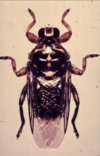
Forest fly
Fam. Hippoboscidae - Hippobosca equina (horse louse fly)

Forest fly
Fam. Hippoboscidae - Lipoptena cervi (deer ked)

Forest fly
Fam. Hippoboscidae - Melophagus ovinus (sheep ked) (wingless)

Mosquito pupa (mummy-like)
Fam. Culicidae
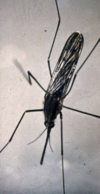
Mosquito
Fam. Culicidae - Anopheles spp. (straight, parallel to surface)

Black fly pupa (slipper-shaped cocoon)

Flesh fly
Fam. Sarcophagidae - Wohlfahrtia spp.

Botfly
Gasterophilinae

Botfly larvea
Gasterophilinae
(GIT of equids)

Hair follicle mites
Prostigmata - Demodicidae - Demodex spp.

Hair follicle mites
Prostigmata - Demodicidae - Demodex spp.

Non-burrowing mite
Astigmata - Fam. Psoroptidae
Psoroptes spp. (3-segmented, long pedicel - “tulip-like”)

Burrowing mite
Astigmata - Fam.Sarcoptidae
Sarcoptes spp.

Soft tick
Metastigmata - Fam. Argasidae - Argas persicus
(pultry, wild birds)
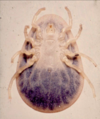
Soft tick
Metastigmata - Fam.Argasidae - Argas persicus
(pultry, wild birds)
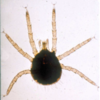
Soft tick nymph (6 legs)
Metastigmata - Fam.Argasidae - Argas persicus?
(pultry, wild birds)

Soft tick
Metastigmata - Fam.Argasidae - Argas reflexus
(pigeons)

Hard tick
Metastigmata - Fam. Ixodidae - Ixodes spp.

Hard tick - head with palps
Metastigmata - Fam. Ixodidae - Ixodes spp.

Hard tick
Metastigmata - Fam. Ixodidae - Dermacentor spp.
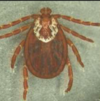
Female hard tick (small scutum)
Metastigmata - Fam. Ixodidae - Dermacentor spp.

Male hard tick (scutum on whole dorsal surface)
Metastigmata - Fam. Ixodidae - Dermacentor spp.

Hard tick
Metastigmata - Fam. Ixodidae

Felicola Subrostatus (Cat) - Chewing or Biting Lice, Suborder Ischnocera (triangular head, 1 pair of arm)

Haematopinus Eurystemus (Cattle) - Blood Sucking lice, Suborder Anoplura

Haematopinus suis (Cattle) - Blood Sucking lice, Suborder Anoplura

Linognatus Vituli (Cattle), Suborder Anoplura

Bovicola Bovis (round head larger than thorax, stripes, 3 pair arms)

Flea
Pulex Irritans

Ischnocera - chwing/biting lice
Werniquella Equi

Lesser mealworm/Darkling beetle
Alphitobius diaperinus

Cimex Lectularius (Bed bug, Family Cimicidae) 5-7mm red brown, blood sucking mouth parts,11 segments in abdomen)

Culex - Head of male (Family Culicidae, mosquitoes)

Culex, head of female (sucking part)

Musca Domestica ( 7-8mm)

Musca Domestica pupa (first white than reddish brown)

Sandfly - Phlebotomus (Family Psychodidae)
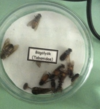
Tabanus (the one on the left) , (Diptera, Suborder Brachycera, division Cyclorrhapha, Family Tabanidae) largest, antennae shorter than head

Fannia Cannicularis Pupa (Diptera, Suborder Brachycera, division Cyclorrhapha, Family Fannidae) Larvae - flattened, bear lateral process on most segments)

Musca Automnalis - Face Flies (5-7mm, smaller than domestic, feed around eyes)
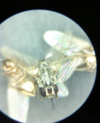
Stomoxys Calcitrans - Stablefly, 6-7mm, piercing mouth part - both sexes heamatophageous

Gasterophilus Intestinalis - pupae (2 big oral hooks, and 1-2 rows of spine, segments)

Warble fly larvae
Hypoderma Diana
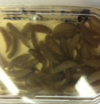
Warble fly larvea
Hypoderma Larvae - 2nd Instar

Warble fly
Hypoderma Larva - Spiraculum

Blow fly
Lucilia Sericata - Brilliant metallic blue

Blow fly pupa
Lucilia Sericata

Sheep Nasal Botfly, Oestrus Ovis

Flesh fly
Sarcophagidae - Wohlfartia magnifica - 12-15 cm, body gray black, not metallic, white spots on abdomen

Flesh fly
Sarcophagidae - Wohlfartia magnifica - 12-15 cm, body gray black, not metallic, white spots on abdomen

Flesh fly
Sarcophagidae - Wohlfartia magnifica - 12-15 cm, body gray black, not metallic, white spots on abdomen

Chorioptes Bovis (non burrowing mite, short unsegmented pedicel)

Psoroptes Bovis & Cuniculi (non burrowing mites, with piercing mouth part and long three segmented pedice, up to 0,8mml)

Psoroptes Bovis & Cuniculi (non burrowing mites, with piercing mouth part and long three segmented pedice, up to 0,8mml)

Sarcoptes Sabiei - Burrowing Mites (anus terminal, 0,4mm) Female burrows tunnel under skin

Argas Persicus - Soft ticks (on poultry, 5-10mm) & Larva 1mm, bluish

Argas Persicus - Soft ticks (on poultry, 5-10mm) & Larva 1mm, bluish

Cheylettiella Blackei & Yasguri- Mites on hair coat (0,4mm)

Cheylettiella Blackei & Yasguri- Mites on hair coat (0,4mm)

Hair follicle mites - Demodex spp.

Hair follicle mites
Histology of demodicosis

Hard tick - Dermacentor

Hard tick - Dermacentor

Hard tick - Dermacentor

Dermanyssus Galinae

Section of engorged hard tick

Section of engorged hard tick
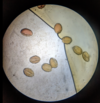
Eggs of hard tick
Dermacentor

Soft tick
Argas persicus

Soft tick larvea
Argas persicus

Red mites
Dermanyssus gallinae
Domestic poultry, wild birds

Harvest (chigger) mites
Trombiculidae autumnalis

Cheyletiella egg on hair
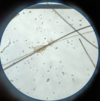
Cheyletiella egg on hair
often empty

Cheyletiella sp.
Look at the “combs” at end of legs
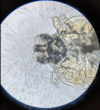
Cheyletiella
Look at the hooks at palps of head

Hair with follicle: Demodex next to hair → dark points
Hair follicle mites - Demodex sp.

Hair with follicle: Demodex next to hair → dark points

Hair follicle mites - Demodex sp.
in dissolved skin scrapings
very pale, hard to find

Hair follicle mites - Demodex sp.
among hairs (very pale, hard to find - next to hairs)

Scaly legs
Knemidokoptes mutans
(poultry and cage birds)

Ear cancer of rabbit
Psoroptes cuniculi
(In ext. ear canal, multilayered epidermal debris w. eroded, bleeding skin surface underneath - ear scratching, head shaking, ear droop - never remove, v. painfull!)

Notoedres cati
Mange

Notoedres cati
Mange

Otodectes cynotis
Ear mite
(dog-rare, cat-common

Knemidokoptes gallinae infection in poultry

Sarcoptes scabiei var suis
can see only the skeleton of mite
cattle have to much dirt and skin particles in the slide, that’s why you have to boil it in ALKALINE
→ all skin and dirt will be removed, only skeleton of mite will be the rest

Oestrus ovis instars from sheep

Hypoderma Diane - third instar larvea

Hypoderma Diana

Warble flies - Hypoderma (no mouthparts! Bumble-bee-like)

Sarcoptes scabiei var. suis

Sarcoptes scabiei var. canis

Sarcoptes scabiei var. canis
Skin scraping

Notoedres cati
Skin craping

Knemidokoptes gallinae causing depluming itch in birds
Start from neck and/or anal region: loss of feathers

Psoroptes ovis
Psoroptic mange
Tags of wool projecting from fleece covering, coin to palm size lesions develop in 2-6 weeks, become dry in center, emaciation, anaemia

Psoroptes ovis
Psoroptic mange
Areas w. long hair: dorsal neck, base of tail
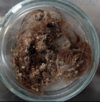
Psoroptes ovis
Skin scraping of sheep

Otodectes cynotis

Sarcoptes scabiei var. bovis
Sarcoptic mange

Sarcoptes scabiei var. bovis
Sarcoptic mange
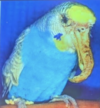
Knemidokoptes pilae

Musca domestica
yellow abdomen
short licking mouth part

Musca domestica

Musca autumnalis

Fannia canucularis (first two segments yellow)

Fannia canicularis

Stomoxys calcitrans
White abd. with black spots, piercing mouthpart

Stomoxys calcitrans

Stomoxys calcitrans

Hornfly - Haematobia irritans
piercing mouthpart (dink blood), smaller
Palps= smaller Head = down

Hornfly - Haematobia irritans
piercing mouthpart (dink blood), smaller
Palps= smaller Head = down

Hornfly - Haematobia irritans
(prefer back and sides)


